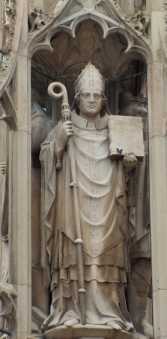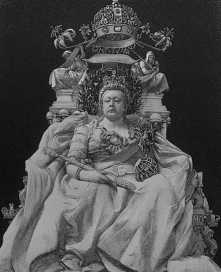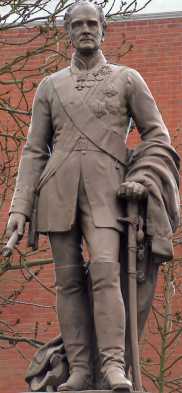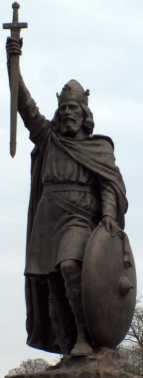 Bishop Wykeham, on the Market Cross, Winchester.
Bishop Wykeham, on the Market Cross, Winchester.
Winchester is just over an hour from London by frequent train from Waterloo.
Winchester’s real interest is for things medieval, but the Cathedral offers work of various 19th C sculptors, which can be contrasted in situ with much earlier work, and together with a handful of sculptural works around the town (including important works by Thornycroft and Gibson), certainly gives enough interest for these Victorian-centric pages. This page covers statues other than in the Cathedral. Ten minutes walk from the station, the principle artery of the town centre is High Street.
 Bishop Wykeham, on the Market Cross, Winchester.
Bishop Wykeham, on the Market Cross, Winchester.
The Westgate is a 12th – 14th C building, originally the gatehouse to a now vanished castle, later on the town jail, now open as a small and most atmospheric museum. The chief exhibit is a ceiling from Winchester College dating from 16th C. This is painted with pattern book designs of portraits, in a black and white pen and ink style. Also little panels of 15th and 16th C stained glass, and some bits and bobs of ironmongery etc. On one wall, a pair of larger figures with wings and grotesqued lower bodies. On the exterior, facing down High Street, is the crumbling remnant of a modest Victorian fountain, dating from 1859, presented by the then Mayor William Hutchison. Water presumably came from the now damaged head of a cherub, below a trefoil Gothic roof.
Beyond, note the characteristic Elizabeth Frink Horse and Rider bronze of 1975.
Beyond that is the 13th C Great Hall, which contains an important 19th C sculptural group. Buildings around include various 19th C legal and council buildings, worked in characteristic materials of Winchester – sandy coloured shale with flint facings. The architect Thomas Henry Wyatt (1807-80) built his ill fated Assize Courts here in 1874, which afterwards had to be demolished when they began to fall down. But his remodelling of the interior of the Great Hall survives.
The Great Hall was built 1222-35 against one wall of the now defunct castle, and is an excellent example of secular early English Gothic. Wyatt’s stained glass designs include 3 standing knights at the Castle wall end, and a variety of small heraldic shields. Modern 1981 stainless steel gates by Anthony Robinson fit in well at the castle end, evocative of a portcullis. On the opposite wall hangs a huge painted oak round table said to be that of King Arthur – above a central Tudor rose is a painting of the seated king.
And what we Victorians have as our excuse to visit, is Alfred Gilbert’s important bronze statue of Queen Victoria (1887). She is shown fairly old, with flamboyant décor –enveloped in robes, carpet, bejeweled, beneath a crownlike art-nouveau canopy with heavy flowers. She holds the usual orb, which in this case is hollow, with a particularly good winged Victory on top. There are two small allegorical females behind, and half a dozen much smaller standing in niches in the structure of the throne. The edifice is completed on the rear with a standing Britannia holding a ship. Good stuff.
 Alfred Gilbert's Queen Victoria.
Alfred Gilbert's Queen Victoria.
At the rear of the Great Hall, a door leads to a charming recreation of a medieval garden, from which one can get out, to see further council offices and regimental museums, including Long Block of 1899-1904 fronting onto a frenchified former parade ground. Slight ruins of castle foundations and lower wall are by the Great Hall.
Walking around the outside of the Great Hall, one can find a further statue: the rather cerebral bronze of John Colborne, Baron Seaton, by George G. Adams.
 G. G. Adams's statue of Baron Seaton.
G. G. Adams's statue of Baron Seaton.
The former Guildhall, 1713, now Lloyds TSB, opposite a 15th C Tudor effort, has a projecting clock with woodwork carved with simple floralisms, and a stone Queen Anne on the front of the same date, with ball and sceptre. Rather a portly affair, exaggeratedly so because we are looking up at her in foreshortened view, and thickly painted.
A few paces further down is Market Cross, fine Gothic on 3 levels, with variety of niches – considered to be among the finest such edifices in England. All in pale stone. 4 statues at 2nd level, 19th C or much restored. Certainly in the 1830s there was just the one statue – generally thought to be St John the Evangelist, or perhaps some martyred saint. The cross stands on 5 steps, the lowest one now partially covered. Engraved ‘The High Cross, MCDXX11-MCDLXI, Restored MDCCC. The 4 statues include a crowned bearded king with, tunic, sword, and cloak – King Alfred – a Queen with sword, a biblical figure with headdress, and what presumably is the restored St John. Above, several tiny saints with good drapes, deep set in niches – again, these look 19th C rather than anything older. And the summit bears a castle or stylised version of the Cathedral. The cross is called by some the ‘butter cross’, from the habit of dealers in butter selling their wares by it until 1772.
A bit further down is a Tudor-style building, with a projecting clock and four medieval-style wooden figures, conveniently labeled as Aethelstan, (Bishop) Fox, Wakelin and William of Wykeham. The projecting upper window is supported on further carved heads of a grotesque nature.
Further along is the impressive 19th Century Guildhall, a Gothic structure with central tower with steeply sloped roof and 4 small corner steeples, and symmetrical projecting wings. It was built in 1871-3, by the architects Jeffery and Skinner, the builders being Joseph Bull and Sons. Mildly polychromatic with white-grey and Winchester’s characteristic yellow stone, and red sandstone for banding and detail. The entrance, reached by grand steps, is under the tower, with granite pillars under several arches. Some attempt at sculptural decoration, though dwarfed by the size of the building, their architectural propriety is questionable. The central tower has a rather small frieze with a dozen robed figures. Each wing has two stone standing kingly figures, unfortunately very worn, and three little scenes in high relief, set in the pointed semicircular spaces above windows in arches. They depict various scenes in the history of Winchester, busy little compositions with figures crouched into the small space, in medieval style and of some merit. Alas, no sign of who made them.
Continuing past the Abbey gardens, at the end is the colossal statue of Alfred the Great by Hamo Thornycroft, dating from 1901. The bronze statue is raised up on an unfinished block of granite. It shows the Saxon king holding his sword forward, cross upward, big round Saxon shield to side. A most powerful and impressive work. (More information on this statue on this page.)
 King Alfred, by Hamo Thornycroft.
King Alfred, by Hamo Thornycroft.
For the interior of the Cathedral, which has a good collection of 19th century sculptural work and earlier monuments, see separate page. The exterior of the Cathedral, by contrast, is rather bare, with no sculpture bar a summit figure on the West Front in a niche, not very prominent, apparently of William of Wykeham. Perhaps 18th Century, more likely 19th.
And nearby, in grounds, there is a statue on the WW1 memorial to the Kings Royal Rifle Corps, a dignified bronze effort by John Tweed (1922).
Finally, near the Cathedral entrance is the City Museum, with good non-figural Roman mosaics, fragmentary 11th-13th C sculpture, and a few medieval tiles some of which are figural. The ground floor has a small 17th C wooden statue of Pomona looking like something by Gauguin. Only slight 19th C interest – a bit of information about Jane Austen, buried in the Cathedral, shop fronts including a recreated tobacco shop, and a maquette of the Alfred statue by Thornycroft.
Winchester Cathedral // Sculpture in England // Sculpture pages
Visits to this page from 23 Nov 2011: 1,687 since 9 September 2024